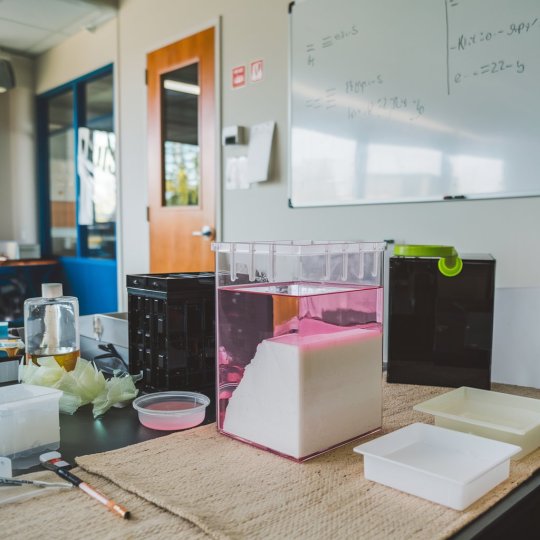#Polymer composites
Explore tagged Tumblr posts
Text
Reinventing Infrastructure: The Role of Polymer Composites in Bridge Rehabilitation
Introduction Bridges are critical components of our transportation infrastructure, facilitating the smooth flow of goods and people. However, over time, these vital structures undergo wear and tear due to factors like heavy traffic, weathering, and aging. To address these challenges, engineers and researchers have been exploring innovative materials and techniques for bridge rehabilitation. One…

View On WordPress
#Bridge Maintenance#bridge rehabilitation#composite materials#construction innovation#corrosion resistance#Durability#engineering advancements#FRP technology#infrastructure enhancement#innovative materials#long-term savings#Polymer composites#seismic retrofitting#structural strengthening#sustainable solutions#transportation systems
0 notes
Text

#Seth Price#2023#Acrylic paint#reverse-transfer print into acrylic polymer#and UV-print on aluminum composite#72 1/4 x 48 x 1 1/4 inches (183.5 x 121.9 x 3.2 cm)#Potience
85 notes
·
View notes
Text
What are the materials used in weapons manufacturing?
Materials used in weapons manufacturing are chosen based on their mechanical properties, durability, and suitability for specific applications. The materials used in weapons manufacturing are:
1. Alloys, including steel, aluminum, titanium, nickel, and cooper. 2. Composites, including carbon fiber, glass fiber, and kevlar. 3. Ceramics, including alumina, silicon carbide, and boron carbide. 4. Polymers, including polyamide, polycarbonate, and polyethylene. 5. Specialized Coatings and Treatments, including ceramic coatings, teflon coatings, and phosphate coatings. 6. Explosives and Propellants, including RDX (Cyclotrimethylenetrinitramine), TNT (Trinitrotoluene), and composite propellants. 7. Electronic and Semiconductor Materials, including silicon, and gallium nitride (GaN).
Alloys
High-Strength Steel - Commonly used in the manufacturing of
Barrels: The main component of a firearm, responsible for propelling projectiles.
Receivers: The housing for the firearm's action, holding essential components.
Slides (pistols): The moving part that houses the barrel and holds ammunition.
Frames (pistols): The base of the handgun, supporting other components.
Bolts and carriers (rifles): Components involved in the firing cycle.
Springs: Essential for firearm operation, providing recoil and return forces.
Steels like 4140, 4340, and maraging steel are known for their toughness, high yield strength, and resistance to wear.............
#science#metals#alloys#materials#materials science#materials science and engineering#composites#ceramics#polymers#engineering#firearm
11 notes
·
View notes
Text
my coworker is making me huff ethanol in the lab
#hes smell testing different polymer compositions but its essentially huffing isopropyl alcohol and ethanol and acrylate#she speaks
4 notes
·
View notes
Text
Noise Aura Buds in-Ear Truly Wireless Earbuds with 60H of Playtime, Quad Mic with ENC, Dual Device Pairing, Instacharge(10 min=150 min),12mm Polymer Composite Driver, BT v5.3(Aura Blue)
Price: (as of – Details) From the manufacturer Up to 60-hour playtime: Enjoy extended usage without frequent recharging.Dual device pairing: Seamlessly connect and switch between two devices simultaneously.Quad mic ENC: Experience crystal-clear communication, even in noisy environments.12mm polymer composite driver: Immerse yourself in rich, detailed sound.InstachargeTM (10min charge = 150min…

View On WordPress
#60H#Aura#Blue#Buds#Composite#Device#Driver#Dual#Earbuds#earbuds yellow#ENC#inEar#Instacharge10#Mic#min12mm#min150#Noise#Pairing#Playtime#Polymer#Quad#v5.3Aura#Wireless
0 notes
Text
The global automotive polymer composites market size reached US$ 9.4 Billion in 2023. The market expects to reach US$ 16.6 Billion by 2032, exhibiting a growth rate (CAGR) of 6.29% during 2024-2032. The escalating demand for lightweight and fuel-efficient vehicles, various technological advancements in the manufacturing processes, and the implementation of stringent government regulations represent some of the key factors driving the market.
0 notes
Text

Material Science
Materials Science is a dynamic and interdisciplinary field that explores the properties, structures, and applications of materials to drive advancements in technology, engineering, and science. By studying the atomic and molecular makeup of metals, ceramics, polymers, composites, and semiconductors, materials scientists develop new materials with enhanced properties. These innovations support industries such as aerospace, electronics, energy, and healthcare. From creating lightweight materials for sustainable energy systems to designing biocompatible materials for medical devices, Materials Science is at the forefront of solving global challenges.
Website : sciencefather.com
Nomination: Nominate Now
Registration: Register Now
Contact Us: [email protected]
#sciencefather#researcher#Professor#Lecturer#Scientist#Scholar#BestTeacherAward#BestPaperAward#MaterialsScience#MaterialsEngineering#Nanomaterials#Metallurgy#Ceramics#Polymers#Composites#Biomaterials#SmartMaterials#SustainableMaterials#EngineeringInnovation
0 notes
Text

#Fiber Reinforced Polymer Composites Market#Global Fiber Reinforced Polymer Composites Market#Global Fiber Reinforced Polymer Composites Market Size#Global Fiber Reinforced Polymer Composites Market Share
0 notes
Text
India Thermoplastic Polymer Composites Market Trends, Growth, Forecast 2023-2030
BlueWeave Consulting, a leading strategic consulting and market research firm, in its recent study, estimated the India Thermoplastic Polymer Composites Market size by value at USD 2.79 billion in 2023. During the forecast period between 2024 and 2030, BlueWeave expects the India Thermoplastic Polymer Composites Market size to expand at a CAGR of 6.22% reaching a value of USD 4.01 billion by 2030. The Thermoplastic Polymer Composites Market in India is propelled by the increasing interest in thermoplastic polymer composites, which is attributed to their numerous benefits including high-volume processability, recyclability, excellent damage resistance, fracture toughness, and the capacity to form intricate shapes. These advanced materials are increasingly being utilized across various transportation sectors, ranging from automobiles to subway systems.
By volume, BlueWeave estimated the India Thermoplastic Polymer Composites Market size at 386.16 thousand tons in 2023. During the forecast period between 2024 and 2030, BlueWeave expects the India Thermoplastic Polymer Composites Market size by volume is projected to grow at a CAGR of 6.09% reaching the volume of 427.36 thousand tons by 2030. Long-fiber thermoplastics (LFTs) are gaining traction in the transportation industry due to their superior performance characteristics. In the automotive sector, high fuel prices have had a significant impact, prompting manufacturers to adopt thermoplastic composites to reduce vehicle weight. It is particularly important as stringent emission regulations push for lower carbon dioxide emissions. By decreasing vehicle mass, thermoplastic composites contribute to improved fuel efficiency and reduced emissions.
Sample Request @ https://www.blueweaveconsulting.com/report/india-thermoplastic-polymer-composites-market/report-sample
Impact of Escalating Geopolitical Tensions on India Thermoplastic Polymer Composites Market
Geopolitical tensions can have a multifaceted impact on the India Thermoplastic Polymer Composites Market by disrupting supply chains and increasing raw material costs. Political instability can lead to sanctions, trade restrictions, and heightened tariffs, affecting the import of critical composite materials and advanced manufacturing technologies. These challenges result in production delays and increased expenses for Indian manufacturers, potentially stifling market growth. Furthermore, global trade uncertainties compel companies to seek local alternatives or invest in domestic production capabilities, which can initially inflate costs and hinder the market's expansion. Stabilizing geopolitical landscapes is crucial for fostering sustainable growth in the India Thermoplastic Polymer Composites Market.
India Thermoplastic Polymer Composites Market
Segmental Coverage
India Thermoplastic Polymer Composites Market – By End User
Based on end user, the India Thermoplastic Polymer Composites Market is divided into Automotive, Aerospace, Electrical & Electronics, Construction, Consumer Goods, and Healthcare segments. The automotive segment holds the highest share in the India Thermoplastic Polymer Composites Market by end user. It is primarily due to the nation's transportation sector contributing significantly to its GDP, approximately 6.3%. The automotive sector, primarily reliant on road infrastructure, manages over 50% of freight and 90% of passenger traffic. Government initiatives and private investments, along with a flourishing FMCG sector, drive the need for efficient connectivity solutions. Liberalization programs and FDI norms further encourage market competition and affordability. Moreover, there's a heightened focus on reducing carbon emissions and enhancing fuel efficiency within the automotive industry. This fuels the demand for thermoplastic composites, particularly continuous fiber-reinforced variants, offering lightweight solutions aligned with sustainability goals and automotive standards.
Competitive Landscape
The India Thermoplastic Polymer Composites Market is fragmented, with numerous players serving the market. The key players dominating the India Thermoplastic Polymer Composites Market include Reliance Industries Limited, Jushi India Fiberglass Co Pvt Ltd, Advanced Composites Pvt Ltd, SGL Carbon India Pvt Ltd, Tata AutoComp Systems Ltd, SABIC Innovative Plastics India Pvt Ltd, Owens Corning India Pvt Ltd, Tufropes Pvt Ltd, RTP Company, and 3B-the fibreglass company (India) Pvt Ltd. The key marketing strategies adopted by the players are facility expansion, product diversification, alliances, collaborations, partnerships, and acquisitions to expand their customer reach and gain a competitive edge in the overall market.
Contact Us:
BlueWeave Consulting & Research Pvt. Ltd
+1 866 658 6826 | +1 425 320 4776 | +44 1865 60 0662
0 notes
Text
New Process Allows Full Recovery of Starting Materials From Tough Polymer Composites - Technology Org
New Post has been published on https://thedigitalinsider.com/new-process-allows-full-recovery-of-starting-materials-from-tough-polymer-composites-technology-org/
New Process Allows Full Recovery of Starting Materials From Tough Polymer Composites - Technology Org
In a win for chemistry, inventors at the Department of Energy’s Oak Ridge National Laboratory have designed a closed-loop path for synthesizing an exceptionally tough carbon-fiber-reinforced polymer, or CFRP, and later recovering all of its starting materials.
A polymer, functionalized carbon fibers and a crosslinker are mixed and cured. The components can be retrieved by addition of an alcohol, pinacol. Credit: Philip Gray and Anisur Rahman/ORNL, U.S. Dept. of Energy
A lightweight, strong and tough composite material, CFRP is useful for reducing weight and increasing fuel efficiency of automobiles, airplanes and spacecraft. However, conventional CFRPs are difficult to recycle. Most have been single-use materials, so their carbon footprint is significant. By contrast, ORNL’s closed-loop technology, which is published in Cell Reports Physical Science, accelerates addressing that grand challenge.
“We incorporated dynamic crosslinking into a commodity polymer to functionalize it. Then, we added a crosslinker to make it like thermoset materials,” said ORNL chemist and inventor Md Anisur Rahman. “Dynamic crosslinking allows us to break chemical bonds and reprocess or recycle the carbon fiber composite materials.”
A conventional thermoset material is permanently crosslinked. Once synthesized, cured, molded and set into a shape, it cannot be reprocessed. ORNL’s system, on the other hand, adds dynamic chemical groups to the polymer matrix and its embedded carbon fibers. The polymer matrix and carbon fibers can undergo multiple reprocessing cycles without loss of mechanical properties, such as strength and toughness.
Rahman led the study with ORNL chemist Tomonori Saito, who was honored by Battelle in 2023 as ORNL Inventor of the Year. Rahman and ORNL postdoctoral fellow Menisha Karunarathna Koralalage conducted most of the experiments. The trio has applied for a patent for the innovation.
“We invented a tough and recyclable carbon fiber composite,” said Saito. “The fiber and the polymer have a very strong interfacial adhesion due to the presence of dynamic bonds.” The interface locks materials together through covalent interactions and unlocks them on demand using heat or chemistry. Saito added, “The functionalized fiber has dynamic exchangeable crosslinking with this polymer. The composite structure is really tough because of the interface characteristics. That makes a very, very strong material.”
Conventional polymers like thermoset epoxies are typically used to permanently bond materials such as metal, carbon, concrete, glass, ceramic and plastic to form multicomponent materials such as composites. However, in the ORNL material, the polymer, carbon fibers and crosslinker, once thermoset, can be reincarnated back into those starting materials. The material’s components can be released for recycling when a special alcohol called a pinacol replaces the crosslinker’s covalent bonds.
Closed-loop recycling at laboratory scale results in no loss of starting materials. “When we recycle the composites, we recover 100% of the starting materials — the crosslinker, the polymer, the fiber,” Rahman said.
“That’s the importance of our work,” Saito said. “Other composite recycling technologies tend to lose the component starting materials during the recycling process.”
Other advantages of the reversibly crosslinked CFRPs are quick thermosetting, self-adhesive behavior and repair of microcracks in the composite matrix.
In the future, closed-loop recycling of CFRPs may transform low-carbon manufacturing as circular lightweight materials become incorporated into clean-energy technologies.
The researchers drew inspiration from nature, which employs dynamic interfaces to create robust materials. Nacre, the iridescent mother-of-pearl inside the shells of marine mussels and other mollusks, is exceptionally tough: it can deform without breaking. Moreover, marine mussels strongly adhere to surfaces but dissipate energy to release when necessary.
The researchers aimed to optimize interfacial chemistry between the carbon fibers and the polymer matrix to boost interfacial adhesion and enhance CFRP toughness. “Our composite’s strength is almost two times higher than a conventional epoxy composite,” Rahman said. “Other mechanical properties are also very good.”
The tensile strength, or the stress a material can bear when it is pulled, was the highest ever reported among similar fiber-reinforced composite materials. It was 731 megapascals — stronger than stainless steel and stronger than a conventional epoxy-based CFRP composite for automobiles.
In the ORNL material, the dynamic covalent bonding between the fiber interface and the polymer had 43% greater interfacial adhesion compared to polymers without dynamic bonds.
The dynamic covalent bonds enable closed-loop recycling. In a conventional matrix material, the carbon fibers are difficult to separate from the polymer. ORNL’s chemical method, which clips fibers at the functional sites, makes it possible to separate fibers from the polymer for reuse.
Karunarathna Koralalage, Rahman and Saito modified a commodity polymer, called S-Bpin, with assistance from Natasha Ghezawi, a graduate student at the Bredesen Center for Interdisciplinary Research and Graduate Education of the University of Tennessee, Knoxville. They created upcycled styrene ethylene butylene styrene copolymer, which incorporates boronic ester groups that covalently bond with a crosslinker and fibers to generate the tough CFRP.
Because CFRP is a complex material, its detailed characterization required diverse expertise and instrumentation. ORNL’s Chris Bowland tested tensile properties. With Raman mapping, ORNL’s Guang Yang showed the distribution of chemical and structural species.
Catalin Gainaru and Sungjin Kim, both of ORNL, captured rheological data, and Alexei Sokolov, a UT-ORNL Governor’s Chair, elucidated it. Scanning electron microscopy by Bingrui Li, of ORNL and UT, revealed that carbon fiber maintained its quality after recycling.
Vivek Chawla and Dayakar Penumadu, both of UT, analyzed interlaminar shear strength. With X-ray photoelectron spectroscopy, ORNL’s Harry Meyer III confirmed what molecules attached to fiber surfaces. ORNL’s Amit Naskar, a renowned expert in carbon fiber, reviewed the paper.
The scientists found that the degree of dynamic crosslinking is important. “We found 5% crosslinking works better than 50%,” Rahman said. “If we increase the crosslinker amount, it starts making the polymer brittle. That’s because our crosslinker has three hand-like bulky structures, able to make more connections and decrease the polymer’s flexibility.”
Next, the research team would like to conduct similar studies with glass-fiber composites, which maintain high performance while lowering the cost and carbon footprint of applications in aerospace, automotive, marine, sporting, construction and engineering. They also hope to reduce costs of the new technology to optimize commercial prospects for a future licensee.
“This step will open more applications, especially for wind turbines, electric vehicles, aerospace materials and even sporting goods,” Rahman said.
The Vehicle Technologies Office in DOE’s Office of Energy Efficiency and Renewable Energy sponsored the research. DOE’s Office of Electricity sponsored Raman mapping.
UT-Battelle manages ORNL for DOE’s Office of Science. The single largest supporter of basic research in the physical sciences in the United States, the Office of Science is working to address some of the most pressing challenges of our time. For more information, please visit energy.gov/science.
Source: Oak Ridge National Laboratory
You can offer your link to a page which is relevant to the topic of this post.
#2023#adhesion#aerospace#airplanes#alcohol#applications#Automobiles#automotive#Behavior#carbon#carbon fiber#carbon footprint#carbon-fiber-reinforced polymer#cell#challenge#chemical#chemical bonds#chemistry#Chemistry & materials science news#composite materials#composites#concrete#construction#data#dept#education#efficiency#electric vehicles#electricity#electron
0 notes
Text
Most people think of coffee cups, bathroom tiles or flower pots when they hear the word "ceramic." Not so Frank Clemens. For the research group leader in Empa's Laboratory for High-Performance Ceramics, ceramics can conduct electricity, be intelligent, and even feel. Together with his team, Clemens is developing soft sensor materials based on ceramics. Such sensors can "feel" temperature, strain, pressure or humidity, for instance, which makes them interesting for use in medicine, but also in the field of soft robotics. Soft ceramics -- how is that supposed to work? Materials scientists like Clemens define ceramics as an inorganic, non-metallic material that is produced from a collection of loose particles in a high-temperature process known as sintering. The composition of ceramics can vary -- and their properties change as a result. But earthenware and porcelain are nowhere to be seen in Clemens' lab. The researchers work with materials such as potassium sodium niobate and zinc oxide, but also with carbon particles.
Read more.
16 notes
·
View notes
Text

#“Do You Want Revenge?#” 2020-22. Acrylic paint#reverse-transfer print into acrylic polymer graphite and UV-print on aluminum composite#Seth price
9 notes
·
View notes
Text
Additive manufacturing, also known as 3-D printing, is a transformative approach to industrial production that is making lighter, stronger parts and systems a possibility.
This article will delve in the concept of additive manufacturing, its types, and the materials used in additive manufacturing.
What is the additive manufacturing?
Additive manufacturing is processes used to create a three-dimensional object by laying down successive layers of material under the control of a computer. Objects created can be of almost any shape or geometry and are created from digital model data. It is intended to construct a part from scratch but raw material, using digital data coming from a CAD file.
The familiar term of additive manufacturing is 3D printing. This is a popular type of additive manufacturing.
#science#materials science#engineering#materials science and engineering#materials#metals#polymers#composites#ceramics#biomaterials#3D printing#additivemanufacturing
2 notes
·
View notes
Text
Ceramic Substrates Market Will Reach USD 11,740.8 Million By 2030
In 2023, the ceramic substrates market was valued at USD 7,721.3 million. Forecasts indicate it will grow significantly, reaching USD 11,740.8 million by 2030, with a projected compound annual growth rate (CAGR) of 6.3% between 2024 and 2030. This growth of the industry can be credited to the increasing need for such materials in many sectors and the trend of the reduction of electronic…

View On WordPress
#3D Printing Materials Market#ceramics#Competitive Landscape#composites#growth prospects#innovations#Investors#Key players#Manufacturers#market drivers#metals#polymers#regulatory landscapes#researchers#Technological advancements#Trends
0 notes
Photo

Cincinnati Deck Inspiration for a large, second-story metal railing deck remodel in the backyard with an addition to the roof.
0 notes
Text
Deck - Uncovered

Example of a mid-sized trendy backyard second story metal railing deck design with no cover
#storage shed#polymer capped decking#composite decking#deck#timbertech#aluminum handrail#deck design
1 note
·
View note